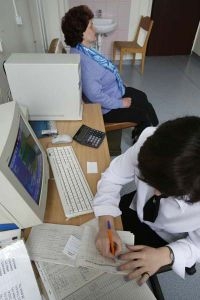Text by Marilyn Smith / Photos by Nigel Dickinson
It is impossible to mark the 20th anniversary of Chernobyl without acknowledging the devastating losses and the ongoing challenges associated with elevated levels of ionizing radiation.
t the same time, we would act amiss if we did not also take this opportunity to recognize achievements and share the knowledge gained. Chernobyl created new challenges in every area of the TC mandate; challenges that evolved as time passed and needs changed.
Generally, the international community recognizes three distinct phases in the response to Chernobyl. From 1986 to 1991, the primary focus was on disaster management and the IAEA was heavily involved in a number of ways. TC began to take on various roles the following year, when the emphasis shifted to radiation protection, rehabilitation and remediation, with special attention devoted to human health and environmental consequences. In 2006, there is broad consensus that although it is vitally important to carry forward ongoing efforts, the time has come to concentrate on the largest outstanding issue: social and economic recovery.
Since 1992, TC has carried out 12 national and regional projects in the Chernobyl area, which now comprises the independent nations of Belarus, Ukraine and a portion of the Russian Federation. It is important to note that even in responding to the disaster, TC has remained true to its strategy of building capacity (through equipment delivery, training and expert advice) to meet high-priority needs identified in government development goals. In many instances, the IAEA investments (a total of $13.5 M over 15 years) attracted contributions from other organizations, spawning broader aid and development projects. In addition, the TC approach has again demonstrated that once the equipment and expertise are in place (e.g., a new radiological laboratory opens), the facility becomes an important resource for government and industry alike.
TC commends the many staff and country counterparts who have worked - and continue to work - diligently to identify and address specific needs in each phase of the post-disaster period. The knowledge acquired through these efforts serves to strengthen the global safety. It also demonstrates the increasingly broad reach of nuclear technologies across sectors that directly contribute to social and economic development.









